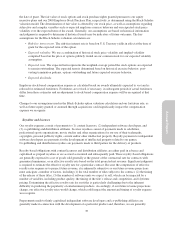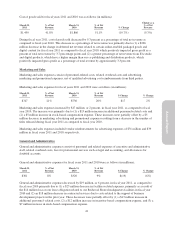Electronic Arts 2011 Annual Report Download - page 107
Download and view the complete annual report
Please find page 107 of the 2011 Electronic Arts annual report below. You can navigate through the pages in the report by either clicking on the pages listed below, or by using the keyword search tool below to find specific information within the annual report.
Annual Report
Revenue Recognition, Sales Returns, Allowances and Bad Debt Reserves
We derive revenue principally from sales of interactive software games (1) on video game consoles (such as the
PLAYSTATION 3, Xbox 360 and Wii), PCs, and handheld game players (such as the PSP and Nintendo DS and
3DS), (2) on mobile devices (such as cellular and smart phones including the Apple iPhone), (3) on tablets such
as the Apple iPad, and (4) from software products and content and online services associated with these products.
We evaluate revenue recognition based on the criteria set forth in Financial Accounting Standards Board
(“FASB”) Accounting Standards Codification (“ASC”) 985-605, Software: Revenue Recognition, and Staff
Accounting Bulletin (“SAB”) No. 104, Revenue Recognition. We evaluate and recognize revenue when all four
of the following criteria are met:
• Evidence of an arrangement. Evidence of an agreement with the customer that reflects the terms and
conditions to deliver products that must be present in order to recognize revenue.
• Delivery. Delivery is considered to occur when a product is shipped and the risk of loss and rewards of
ownership have been transferred to the customer. For online game services, delivery is considered to
occur as the service is provided. For digital downloads that do not have an online service component,
delivery is generally considered to occur when the download is made available.
• Fixed or determinable fee. If a portion of the arrangement fee is not fixed or determinable, we
recognize revenue as the amount becomes fixed or determinable.
• Collection is deemed probable. We conduct a credit review of each customer involved in a significant
transaction to determine the creditworthiness of the customer. Collection is deemed probable if we
expect the customer to be able to pay amounts under the arrangement as those amounts become due. If
we determine that collection is not probable, we recognize revenue when collection becomes probable
(generally upon cash collection).
Determining whether and when some of these criteria have been satisfied often involves assumptions and
management judgments that can have a significant impact on the timing and amount of revenue we report in each
period. For example, for multiple element arrangements, we must make assumptions and judgments in order to
(1) determine whether and when each element has been delivered, (2) determine whether undelivered products or
services are essential to the functionality of the delivered products and services, (3) determine whether vendor
specific objective evidence (“VSOE”) exists for each undelivered element, and (4) allocate the total price among
the various elements we must deliver. Changes to any of these assumptions or management judgments, or
changes to the elements in a software arrangement, could cause a material increase or decrease in the amount of
revenue that we report in a particular period.
Depending on the type of product, we may offer an online service that permits consumers to play against others
via the Internet and/or receive additional updates or content from us. For those games that consumers can play
via the Internet, we may provide a “matchmaking” service that permits consumers to connect with other
consumers to play against each other online. In those situations where we do not require an additional fee for this
online service, we account for the sale of the software product and the online service as a “bundled” sale, or
multiple element arrangement, in which we sell both the software product and the online service for one
combined price. We defer net revenue from sales of these games for which we do not have VSOE for the online
service that we provided in connection with the sale, and recognize the revenue from these games over the
estimated online service period, which is generally estimated to be six months beginning in the month after
shipment. In addition, for some software products we also provide updates or additional content (“digital
content”) to be delivered via the Internet that can be used with the original software product. In many cases we
separately sell digital content for an additional fee; however, some purchased digital content can only be
accessed via the Internet (i.e., the consumer never takes possession of the digital content). We account for online
transactions in which the consumer does not take possession of the digital content as a service transaction and,
accordingly, we recognize the associated revenue over the estimated service period. In other transactions, at the
date we sell the software product we have an obligation to provide incremental unspecified digital content in the
future without an additional fee. In these cases, we account for the sale of the software product as a multiple
element arrangement and recognize the revenue on a straight-line basis over the estimated period of game play.
31
























